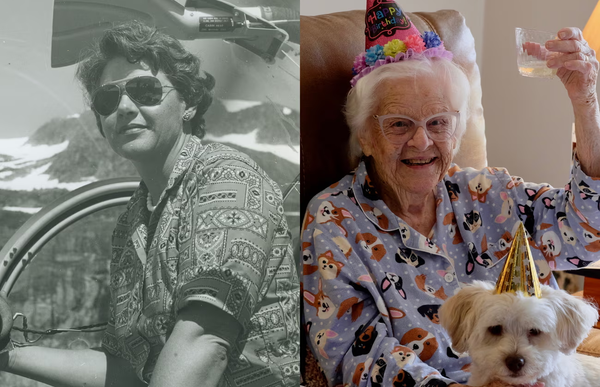Would you swim with a robot dolphin?

In San Jose, California, kindergarteners are sitting at the edge of an outdoor pool when a sleek two-meter-long mass breaches in front of them, water dripping off its smooth gray skin. It stops and enthusiastically nods, splashing the children as their jaws drop in awe. A thin, barely perceptible cord running from its navel to a control panel nearby is the only obvious sign that this is no dolphin—it’s a robot. Delle, a prototype animatronic dolphin currently undergoing testing in San Jose, became a media sensation in 2020 because of its hyperrealistic features. Created by Edge Innovations—the Hollywood special effects company behind the killer whale in Free Willy, the snake in Anaconda, and the dolphin in Flipper—Delle was designed to revolutionize traditional captive animal demonstrations.
One of long COVID’s worst symptoms is also its most misunderstood
On March 25, 2020, Hannah Davis was texting with two friends when she realized that she couldn’t understand one of their messages. In hindsight, that was the first sign that she had COVID-19. It was also her first experience with the phenomenon known as “brain fog,” and the moment when her old life contracted into her current one. She once worked in artificial intelligence and analyzed complex systems without hesitation, but now “runs into a mental wall” when faced with tasks as simple as filling out forms. Her memory, once vivid, feels frayed and fleeting. Former mundanities—buying food, making meals, cleaning up—can be agonizingly difficult. Her inner world—what she calls “the extras of thinking, like daydreaming, making plans, imagining”—is gone. The fog “is so encompassing,” she told me, “it affects every area of my life.”

Nobel recognizes original Berkeley quantum experiment on ‘spooky action at a distance'
In 1971, graduate student Stuart Freedman and postdoctoral fellow John Clauser took over a room in the sub-basement of Birge Hall at the University of California, Berkeley, and built an experiment that would put to the test one of the most enduring weirdnesses of quantum mechanics, what Einstein called “spooky action at a distance.” That experiment was the first to show that quantum mechanics really is weird. Two particles, once linked quantum mechanically, or entangled, can be separated by large distances — even the diameter of the universe — and still “know” what happens to one another. The research was Freedman’s Ph.D. dissertation in 1972, but he subsequently moved onto a broad range of subfields of physics, all related to quantum mechanics, and died tragically in 2012.

Why do some female hummingbirds crossdress as males?
A lot of people are familiar with the idea that many birds are color-coded by sex: males are brilliant whilst females are drab. But hummingbirds have turned this perception onto its head because in some species, a portion of adult females have flashy male-like plumage coloring and patterns that makes them visually indistinguishable from males. Why? When males and females share chick-rearing duties equally, they typically have identical plumage colors and patterns because both males and females are choosing their mates. But plumage transvestism, where some females in a population are indistinguishable males, is especially common amongst hummingbirds. Yet paradoxically, only female hummingbirds build nests and raise chicks, so clearly something strange is happening with them.

How the legendary Swiss Army knife came to be
It has been 125 years since Karl Elsener had the Officers’ and Sports Knife patented, and although the main manufacturer, Victorinox Société Anonyme, has expanded its line of cutlery and tools to about 400, the original has not changed much — and is still a bestseller. Elsener founded Victorinox AG in Ibach, Canton Schwyz in 1884, as a manufacturer of knives and surgical equipment. That output began to expand in 1891, with an advance in Swiss infantry weaponry. In 1890, the Schmidt-Rubin Model 1889 rifle began replacing the Vetterli Model 1869/71. The Swiss army issued a screwdriver with each Vetterli, but with the introduction of the new weapon, the War Technical Department decided to make a multifunction pocket knife standard, not only with blades and screwdrivers for cleaning and maintenance of the rifle but an awl for punching holes in leather and a device for opening the increasingly popular canned rations.

The porcelain challenge didn’t need to be real to cause a panic
Despite what you may have heard, the teens are not stealing their family’s fine dinnerware, tossing it in a blender, and snorting the resulting dust for the “porcelain challenge.” That’s just what Sebastian Durfee, a 23-year-old actor and TikTok creator, hoped you might believe when he spread the word on social media of the latest dangerous teen challenge. On Saturday, Durfee posted a call to action to his followers: to work together to get “boomers to freak out about a fake TikTok challenge.” He chose the porcelain challenge because it seemed like something that would be plausibly dangerous, but not something “the average person could go off and do very easily,” he told me this week. His original video quickly passed half a million views, and TikTok slapped a warning on it for promoting dangerous acts.

The unlikely story of how competitive Tetris went viral
In 1990, a 13-year-old named Thor Aackerlund walked into the Nintendo World Championships to compete in Tetris and left a god. He obliterated every previously held Tetris record. Then, he disappeared. Adding to his mystery, the Nintendo World Championship (NWC) was a one-time deal. So Aackerlund remained the last true Tetris champion for nearly two decades. In fact, it wouldn’t be until 2009 when someone could finally lay claim to Aackerlund’s throne. “Harry Hong became the first person to score a ‘max-out’ — or 999,999 points, the highest score possible — on NES Tetris,” Adam Cornelius tells me. “It was then that I realized there wasn’t an official competition that could crown an official champion.”

The fastest method for transmitting data involves pigeons
Few know it, but the fastest standard for sending data is RFC 1149, the standard for transmitting IP data with birds, especially pigeons.
— Ethan Mollick (@emollick) August 11, 2022
It has been implemented (at 0.08 bps). But pigeons carrying memory cards can hit 28 gigs/second! Speed comparisons: https://t.co/ORlpm5hH82 pic.twitter.com/g61MFQN991



